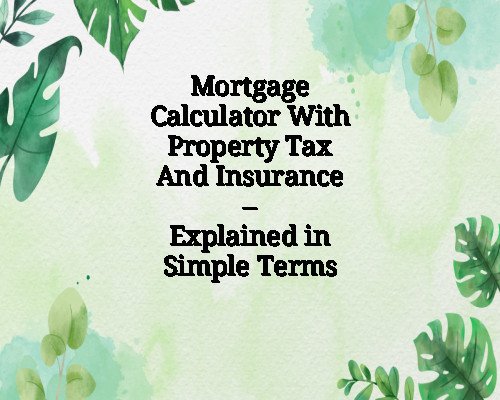Mortgage Calculator With Property Tax And Insurance – Explained in Simple Terms
A mortgage calculator with property tax and insurance is a tool designed to help homeowners or potential buyers determine the total monthly cost of their mortgage, including property taxes and homeowners insurance. It provides a more accurate estimate of what you’ll pay each month, considering all essential factors that influence the cost of homeownership.
This article will walk you through how this calculator works and why it’s useful, as well as the steps involved in using it. By the end, you’ll understand how to compute your monthly payment with property taxes and insurance factored in, which can help you plan your budget more effectively.
What Is a Mortgage Calculator?
A mortgage calculator is a tool that helps you estimate your monthly mortgage payments. It takes into account several key factors like the loan amount, interest rate, and loan term. A basic mortgage calculator can give you a rough idea of how much you might pay every month to cover your mortgage.
However, the true cost of homeownership extends beyond the loan payment itself. You’ll also need to account for property taxes, homeowner’s insurance, and possibly private mortgage insurance (PMI), if applicable.
That’s where a mortgage calculator with property tax and insurance comes in. This advanced version of the basic calculator includes these additional expenses to give you a more accurate monthly payment estimate.
How Does a Mortgage Calculator With Property Tax and Insurance Work?
When you enter your mortgage details into the calculator, it doesn’t just compute the principal and interest; it also factors in property taxes and insurance premiums. Here’s how it works:
-
Loan Information: First, you input the loan amount (how much you’re borrowing), the interest rate, and the loan term (the length of time you’ll be paying back the loan, typically 15, 20, or 30 years).
-
Property Tax: Property taxes vary depending on where you live. Typically, they are calculated as a percentage of your home’s value. For example, if your property tax rate is 1.2% and your home is worth $300,000, your annual property tax would be $3,600.
-
Homeowners Insurance: Homeowners insurance is another important cost that protects you from damages to your home or property. The cost of homeowners insurance can vary, but it’s typically between $500 and $1,500 per year, depending on the value of the home and the coverage level.
-
Private Mortgage Insurance (PMI): If your down payment is less than 20% of the home’s purchase price, you’ll likely need to pay for PMI. This is an additional cost added to your monthly payment until you reach 20% equity in your home.
-
Total Monthly Payment: Once all of these details are entered, the calculator will estimate your total monthly payment. This includes the mortgage payment (principal and interest), property taxes, homeowners insurance, and PMI (if applicable).
Why Is It Important to Include Property Taxes and Insurance?
When you get a mortgage, your lender may set up an escrow account, which allows them to collect money for property taxes and insurance along with your regular mortgage payment. The lender then pays these bills on your behalf. Knowing how much you need to set aside each month for these expenses is crucial for budgeting.
Here’s why factoring in property taxes and insurance is essential:
-
More Accurate Budgeting: If you only consider your mortgage payment, you’re underestimating the full cost of owning a home. Including property taxes and insurance gives you a clearer picture of your financial commitments.
-
Avoid Surprises: Many homeowners are caught off guard when their escrow payments increase due to higher property taxes or insurance premiums. By using a mortgage calculator with taxes and insurance, you can anticipate potential changes in these costs.
-
Lender’s Requirements: Lenders often require homeowners to pay for property taxes and insurance through an escrow account. This means that your monthly mortgage payment will be higher than just the loan repayment itself.
Example of How a Mortgage Calculator Works With Property Tax and Insurance
Let’s look at an example to see how a mortgage calculator with property tax and insurance works in real life.
-
Home price: $300,000
-
Down payment: 20% ($60,000)
-
Loan amount: $240,000
-
Interest rate: 4% annually
-
Loan term: 30 years
-
Annual property tax: 1.2% of home value ($3,600)
-
Annual homeowners insurance: $1,200
Now, let’s break down the numbers:
-
Mortgage Payment: Using the formula for a fixed-rate mortgage, we calculate the monthly mortgage payment for the loan amount of $240,000 at 4% interest over 30 years. This comes out to about $1,145.80 per month for principal and interest.
-
Property Taxes: Divide the annual property tax ($3,600) by 12 months to get the monthly property tax amount. This comes out to $300 per month.
-
Homeowners Insurance: Divide the annual insurance premium ($1,200) by 12 to get the monthly insurance amount, which is $100 per month.
-
Total Monthly Payment: Add all of these amounts together:
-
Mortgage Payment: $1,145.80
-
Property Taxes: $300
-
Homeowners Insurance: $100
-
Total: $1,545.80 per month.
-
So, in this example, your total monthly mortgage payment, including property taxes and insurance, would be $1,545.80.
Key Takeaways
-
Incorporating all costs: A mortgage calculator with property tax and insurance gives you a realistic idea of what you’ll pay each month, which includes more than just the mortgage principal and interest.
-
Escrow payments: If your lender requires an escrow account for property taxes and insurance, your total monthly payment will include these costs along with your mortgage payment.
-
Budgeting: Knowing the full picture of your monthly payment helps you manage your finances more effectively and avoid surprises.
By using a mortgage calculator with property tax and insurance, you can gain a better understanding of the true cost of homeownership and ensure you’re financially prepared for what lies ahead.

